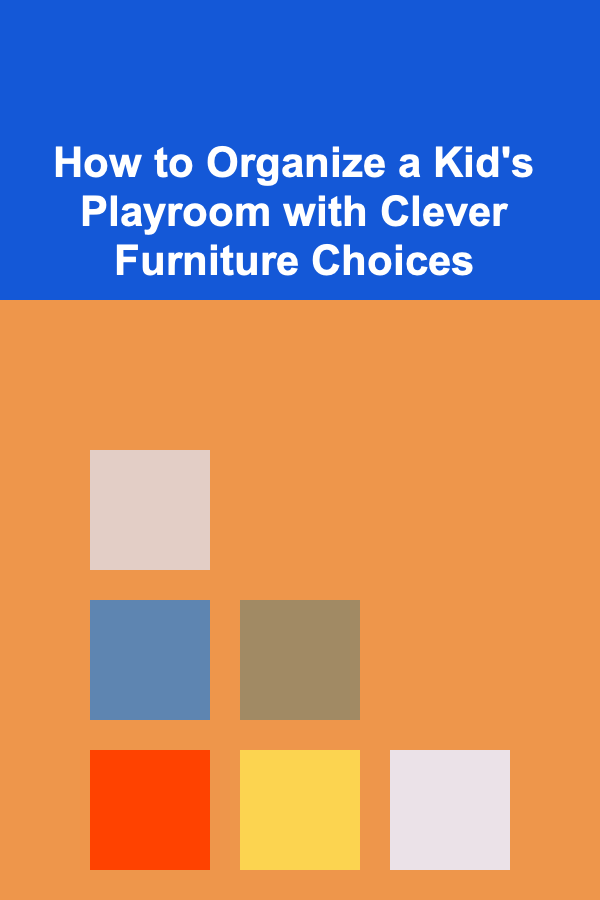
How to Organize a Kid's Playroom with Clever Furniture Choices
ebook include PDF & Audio bundle (Micro Guide)
$12.99$7.99
Limited Time Offer! Order within the next:

Creating an organized and functional playroom for children is essential for fostering creativity, independence, and playtime enjoyment. However, without thoughtful organization and clever furniture choices, the playroom can quickly become chaotic and overwhelming. This comprehensive guide will explore innovative strategies for organizing a kid's playroom, focusing on practical furniture solutions that maximize space, enhance functionality, and create a joyful environment for play.
Introduction
Designing a functional and engaging playroom requires more than just choosing colorful decor and fun toys. It involves crafting a space where children can express themselves freely while ensuring that it remains organized and safe. Clever furniture choices and strategic planning play pivotal roles in achieving this goal. In this article, we will dive deep into how to organize a kid's playroom effectively, providing a roadmap for parents and caregivers to create an inspiring environment tailored to their children's needs.
Understanding the Needs of Children
Developmental Stages
Children go through various developmental stages, each influencing their play habits and preferences:
- Infants (0-12 months): Require safe spaces for tummy time and sensory exploration.
- Toddlers (1-3 years): Need areas for active play, manipulation of objects, and imaginative play.
- Preschoolers (3-5 years): Thrive in environments that encourage pretend play, social interactions, and fine motor skills.
- School-Age (6+ years): Benefit from zones for homework, creative projects, and collaborative activities.
Safety Considerations
Safety is paramount when designing a playroom. Furniture should be child-sized, durable, and free from sharp edges. Additionally, storage solutions should ensure that items are easily accessible yet secure enough to prevent accidents.
Essential Features of a Playroom
Flexibility
A successful playroom must adapt as children grow and their interests evolve. Flexible furniture options can accommodate changing play patterns and learning phases.
Accessibility
All toys and materials should be easily reachable by children. This independence fosters self-sufficiency and encourages kids to take responsibility for their belongings.
Organization
Effective organization helps minimize clutter and chaos, making it easier for children to find and put away their toys, thus reinforcing good habits.
Choosing the Right Furniture
Play Areas
Imaginative Play Furniture
- Play Kitchens: These encourage role-playing and collaboration among peers. Look for compact, multi-functional models that include storage underneath.
- Dress-Up Stations: A small wardrobe or rack for costumes invites imaginative adventures. Ensure it has clear visibility to make selection easy.
- Building Blocks and Activity Tables: Tables designed for building blocks or arts and crafts provide a dedicated space for creativity.
Creative Spaces
- Art Stations: Use small art tables equipped with storage for supplies. Consider adding easels for painting and drawing.
- Reading Nooks: Cozy chairs with bookshelves nearby encourage literacy and calm reading moments. Incorporate soft lighting to create an inviting atmosphere.
Storage Solutions
Open Shelving Units
Open shelving allows for easy visibility of toys and materials, helping children recognize where everything goes. This promotes independence in clean-up and retrieval.
Bins and Baskets
Colorful bins and baskets can hold smaller items like LEGO pieces, crayons, or dolls. Labeling these containers helps with organization and teaches kids about categorization.
Multi-functional Furniture
- Ottomans with Storage: These can serve as seating but also hide away toys and games when not in use.
- Convertible Tables: Tables that adjust in height or purpose can transition from play to study as children grow.
Seating Options
Child-Sized Furniture
Ensure that all seating is appropriately sized for children. Low benches or poufs can offer flexible seating arrangements.
Comfortable Flooring
Soft flooring options, such as foam mats or rugs, provide comfort during playtime while being easy to clean.
Zoning the Space
Creating Functional Zones
To maximize functionality, consider dividing the playroom into specific zones based on activity types:
- Active Play Zone: Designate an area for climbing structures, tumbling mats, or physical games.
- Creative Arts Zone: Set up areas for painting, crafting, or building, complete with the necessary supplies.
- Quiet Reading Zone: Include comfortable seating and book storage for moments of calm and relaxation.
- Imaginative Play Zone: Allocate space for dress-up, pretend kitchens, or puppet theaters to encourage role-play.
Visual Dividers
If the layout allows, use furniture to act as natural dividers between zones. For example, a low bookshelf can separate the arts area from the quiet zone without hindering sight lines.
Creative Storage Solutions
Vertical Storage
Utilize wall space for vertical storage solutions, such as pegboards or hanging organizers, to keep frequently used items within reach. This maximizes floor space and keeps items off surfaces.
Under-Bed Storage
For playrooms with limited space, consider beds with built-in storage drawers. This hidden storage can house seasonal toys or less frequently used items.
Seasonal Rotation
Rotate toys seasonally to keep the playroom fresh and engaging. Store out-of-season items in labeled bins to save space and prevent overload.
Incorporating Flexibility and Adaptability
Modular Furniture
Look for modular furniture that can be reconfigured as needed. This allows for changes in layout based on different activities or group sizes.
Adjustable Height Furniture
Using adjustable tables or chairs can accommodate users of varying ages and sizes, ensuring that furniture remains functional through different developmental stages.
Portable Solutions
Furniture on wheels, such as rolling carts or lightweight tables, offers flexibility for rearranging the space for different activities or cleaning purposes.
Personalizing the Space
Thematic Decor
Incorporate themes that resonate with your child's interests. Whether it's space, dinosaurs, or princesses, integrating these elements can make the space more inviting.
Artwork and Displays
Encourage creativity by displaying children's artwork on walls or using clipboards for easy rotation. This instills pride in their accomplishments and personalizes the room.
Family Involvement
Engage kids in the decorating process. Allow them to help choose colors, furniture styles, or specific accessories, giving them ownership of their space.
Maintaining Order in the Playroom
Regular Clean-Up Routines
Establish a daily or weekly clean-up routine where children participate in tidying up the space. Use songs or timers to make it a fun activity.
Easy Access to Cleaning Supplies
Place cleaning supplies like wipes, brooms, or dustpans in convenient locations, teaching children about cleanliness and responsibilities.
Encouragement and Praise
Encourage children to maintain their organized playroom by praising their efforts and celebrating their achievements in keeping the space tidy.
Case Studies: Successful Kid's Playrooms
Case Study 1: Bright and Bold Playroom
In a bright and colorful playroom, the space was divided into zones using area rugs and low bookshelves. Brightly colored bins held toys, while a cozy reading nook featured oversized cushions. The parents engaged their children in selecting decor, resulting in a personalized and inviting environment.
Case Study 2: Multi-Functional Learning Space
A playroom designed with learning in mind included adjustable tables for arts and crafts, a corner for STEM activities with building blocks, and a cozy reading nook. Modular seating allowed for quick changes in configuration based on the day's activities, promoting versatility.
Case Study 3: Nature-Inspired Playroom
In a nature-inspired playroom, furniture made from natural materials added warmth and coziness. A designated garden corner included planting supplies and outdoor-themed toys. Children were involved in creating displays featuring their nature artwork, fostering creativity and connection to the outdoors.
Conclusion
Organizing a kid's playroom with clever furniture choices is crucial for creating a functional, engaging, and inspiring environment. By understanding children's developmental needs and thoughtfully selecting versatile furniture, parents can create zones that foster creativity while minimizing chaos.
This guide has provided insights into designing a kid's playroom that balances organization with fun. Emphasizing safety, accessibility, and personalization will ensure that the playroom becomes a cherished space for both children and parents alike. By implementing these strategies, you can cultivate a playroom that inspires joy, learning, and adventure for years to come.

How to Leverage Technology in Property Management
Read More
How to Prevent Break-Ins with Landscaping and Outdoor Security Tips
Read More
How to Set Conference Goals and Objectives: An Actionable Checklist
Read More
How to Use Pendant Lights to Elevate Your Kitchen Design
Read More
Lowering Student Loan Payments: Smart Options You Should Consider
Read More
Mastering Product Analysis: Advanced Strategies for Actionable Insights and Growth
Read MoreOther Products

How to Leverage Technology in Property Management
Read More
How to Prevent Break-Ins with Landscaping and Outdoor Security Tips
Read More
How to Set Conference Goals and Objectives: An Actionable Checklist
Read More
How to Use Pendant Lights to Elevate Your Kitchen Design
Read More
Lowering Student Loan Payments: Smart Options You Should Consider
Read More